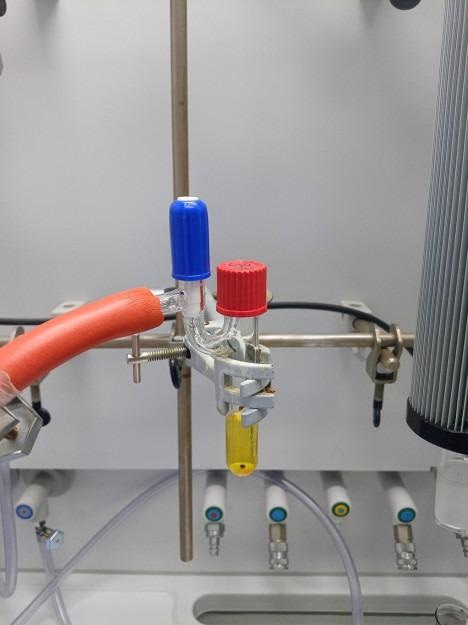Reviewed by Alex SmithMay 26 2022
Molecules with atoms connected in rings are becoming increasingly relevant in the search for potential active drugs in medicine. Such ring systems have features that make them particularly well suited for the production of active drugs, and they are driving the development of novel therapies for cancer, as well as neurodegenerative and infectious diseases.
 The reaction tube, containing the reaction components and the photocatalyst dissolved in solvent hexafluoroisopropanol, is connected to the argon/vacuum manifold. Image Credit: University of Münster–Peter Bellotti.
The reaction tube, containing the reaction components and the photocatalyst dissolved in solvent hexafluoroisopropanol, is connected to the argon/vacuum manifold. Image Credit: University of Münster–Peter Bellotti.
Prof. Frank Glorius from the University of Münster and a team of chemists have now successfully synthesized new and medically significant small molecular rings, which are difficult to produce because they are highly sensitive. The results of the team’s research were published in the journal “Nature Catalysis.”
The production of small ring systems from the so aromatic chemicals is thought to be challenging. In addition, the procedure often necessitates a significant amount of energy. Another stumbling block is that the energy must be delivered selectively to the source materials while avoiding heat-sensitive products. Nonetheless, the team, headed by Frank Glorius, has now created an approach in which visible light is used to activate a photocatalyst, which accelerates the process.
The light is absorbed by the photocatalyst, which then transmits its energy to the source materials. As a result, it is possible to carry out synthesis that is both efficient and mild, with no or few undesirable side effects.
We see our study as a breakthrough in synthesis chemistry. It shows that light energy can be used in a targeted way to produce small ring systems. The fact that, by using different reaction partners, we can produce different ring systems provides numerous opportunities for the production of active agents.
Dr. Jiajia Ma, Study Lead Author, Organisch-Chemisches Institut, Westfälische Wilhelms-Universität Münster
The chemists utilized only readily available, low-cost raw ingredients as their source materials.
Prof. Kendall Houk of the University of California, Los Angeles (USA), was involved in the research. Prof. Kendall Houk is a world-renowned specialist in computer chemistry. Shuming Chen, a professor at the prestigious American undergraduate institution, Oberlin College, assisted Houk with their computer computations (Ohio). The researchers were able to understand the underlying reaction mechanism by working together.
The German Research Foundation (Collaborative Research Centre 858, Leibniz Prize) and the European Research Council (ERC Advanced Grant Agreement No. 788558) supported Frank Glorius’ team financially. The National Science Foundation provided funds to Kendall Houk’s group (Grant CHE-1764328).
Journal Reference:
Ma, J., et al. (2022) Facile access to fused 2D/3D rings via intermolecular cascade dearomative [2 + 2] cycloaddition/rearrangement reactions of quinolines with alkenes. Nature Catalysis. doi.org/10.1038/s41929-022-00784-5.